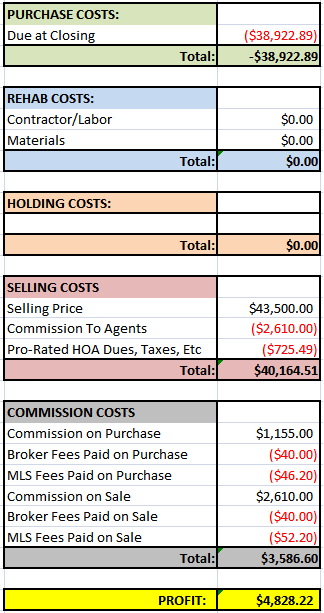We sold The Mirror House today…
Other than the fact that we had to hold this property for three months (due to restrictions by the short sale lender when we bought it), this was a pure wholesale deal. The buyer is an investor friend of mine who holds rentals, and I have a feeling this is going to make a great long-term hold for him. In fact, had we not sold it to him, we probably would have held it as a rental ourselves.
Here is the full final analysis for this one…
Timelines
Here are the key timeline milestones:
- Purchase Offer Date: 3/26/2012
- Purchase Closing Date: 6/19/2012
- Rehab Completion Date: 6/19/2012
- Sale Listing Date: 6/20/2012
- First Sale Contract Date: 6/20/2012
- Final Sale Contract Date: 6/20/2012
- Sale Closing Date:9/18/2012
Financials
Here is the breakdown of financials for this project:

Final Statistics
Here are just some of the final statistics that I’ve been tracking for all my projects, and that summarize the success/failure of each project pretty well:
- From Offer to Purchase Time: 85 Days
- Rehab Time: 0 Days
- Selling Days on Market: 0 Days
- Selling Close Time: 90 Days
- Total Hold Time (Close to Close): 91 Days
- Total Profit: $4,828.22
- Return on Investment (ROI): 12.75%
- Annualized ROI: 51.16%




I’m a regular follower of your site. Thanks for sharing so much info.
Just curious (I’m a newbie). What factors make a property a good candidate for a long term hold.
Thanks,
even though you use your own cash to finance the deal …I think you should still put how much it cost you to freeze your cash for 90 days. you could invest cash somewhere else for a return given comparable risk…?
Asbestos –
Actually, including opportunity cost as an expense wouldn’t make any sense in a profit or ROI context. When doing a net present value and/or IRR analysis prior to doing a deal, the cost of capital (and/or opportunity cost) is certainly important, but that’s generally going to be done BEFORE the project starts to determine if the project is worth pursuing. That’s the whole goal of the NPV/IRR analysis — to determine that the returns should surpass your hurdle (your cost of capital).